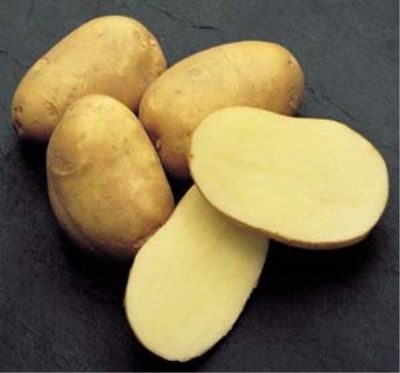
- Authors: HZPC HOLLAND B.V. (Holland)
- Appeared when crossing: Shepody x RZ-84-2580
- Name synonyms: Innovator
- Year of approval: 2005
- Appointment: table, suitable for making French fries, chips
- Tuber size: large
- Tuber weight, g: 83-147
- Peel color: yellow
- Color of the pulp: light yellow
- Starch content,%: 12,0-15,0%
The innovator is a high-yielding potato variety that attracts gardeners with a strong immunity to common diseases and pests. It is worth considering the main characteristics of the culture and the rules for its cultivation.
Breeding history
Breeders from Holland were engaged in breeding of the Innovator potato. For the first time, bushes of a high-yielding plant were brought to Russia in 1997. After the conducted variety trials in 2005, the variety was registered in the State Register.
Description of the variety
The innovator is potatoes with a stable harvest. The main characteristics of the variety:
bushes - semi-erect and spreading;
stems - powerful, growing quickly;
leaves are large, light green;
flowers - large, white.
Rarely do potatoes form berries during the growth process.
Characteristics of the appearance of the bush and root crops
The average height of the Innovator bush reaches 60-70 cm under favorable growing conditions. Tuber characteristics:
shape - oval or oblong;
peel - light with small eyes, yellow tint;
the pulp is light cream in color, soft.
On average, up to 11 large potatoes are formed in the nest, suitable for eating.
Purpose and taste of tubers
The innovator has established itself among gardeners as one of the best varieties of potatoes, which is ideal for preparing main courses and salads. The tubers are also used in the food industry, making chips and mashed potatoes.
The average keeping quality is 95%. Root crops tolerate any mechanical damage due to their dense peel, suitable for long-distance transportation.
Maturation
On average, the first tubers are formed 75-85 days after planting the potatoes.
Yield
The yield per hectare reaches an average of 155-329 centners, which is higher compared to other varieties. With careful care, it will be possible to collect up to 344 c / ha.
Growing and care
The innovator is an unpretentious variety. Before you start planting potatoes, you need to decide on the timing, as well as prepare the root crops. Basically, the planting of crops begins in mid-May or closer to the end of the month, when the frosts leave, and the soil temperature rises to +7 degrees.
Preparation is performed 1-1.5 months before planting.
Tubers are carefully sorted, selecting large and medium potatoes.
Root vegetables are laid out in 2-3 layers in boxes.
They put containers for storage in a room with a temperature of up to +17 degrees.
1-2 weeks before planting, the tubers are re-sorted, rejecting root crops without seedlings.
The remaining material is treated with growth stimulants according to the instructions and sprayed with special compounds to prevent the attacks of the Colorado potato beetle.
Then they start planting potatoes according to the scheme 70x25-40 cm.If the tubers are small, they can be planted densely, large ones are better planted away from each other. Competently maintained distance will allow you to easily loosen the soil and hilling plants.To achieve high yields, you need to take care of proper care. Main steps.
Watering. Potatoes are undemanding to watering, so it is recommended to apply water a maximum of 3 times per season: after planting, during flowering and tuber formation.
Top dressing. Gardeners advise to fertilize the soil with organic compounds before planting potatoes. You can add wood ash or manure to the bottom of the hole dug under the tuber. It is also recommended to feed the plant during the flowering period, when the variety needs strength to form large potatoes.
Hilling. The procedure is carried out mainly after rains or watering, the total number of times is at least three. Before hilling, it is recommended to weed the rows and row spacings in order to improve the yield and taste of the root crops.
You can start harvesting for 75-85 days.

Planting potatoes is one of the main spring activities traditional for Russian gardeners. There are many ways to plant this vegetable, allowing you to get a good harvest in different conditions and climates. Before planting, you need to carefully prepare the planting material, correctly determine the timing, competently prepare the soil.


Soil requirements
The innovator is undemanding to the composition of the soil. Potatoes can be grown on almost any soil, however, the variety will give the maximum yield only on fertile sandy loam. Additionally, it is worth taking a closer look at the acidity of the soil, giving preference to neutral or slightly acidic areas. If necessary, you can lower the pH value with lime or dolomite flour in a volume of 500 g and 200 g, respectively.
Preparing the soil before planting potatoes involves the introduction of organic fertilizers: humus or compost. During autumn plowing, it is recommended to feed the soil with superphosphate compounds.

Disease and pest resistance
Potatoes are resistant to typical diseases and pests. The plant withstands attacks:
pale nematode;
potato cancer;
late blight;
scab.
However, despite strong immunity, potatoes are exposed to cyst nematode, which begins to parasitize on bushes, as well as rhizoctonia. If damaged shoots are found, it is worth removing them and carrying out preventive treatment with special means.

Potatoes are a popular vegetable crop that many gardeners planted on their site. But growing a bountiful harvest of tasty and large tubers is unlikely to succeed if the beds are not properly protected from the most common diseases and pests. Often, the development of diseases of various etiologies of potatoes goes unnoticed, so it is important to identify the problem in time and eliminate it.
















































































